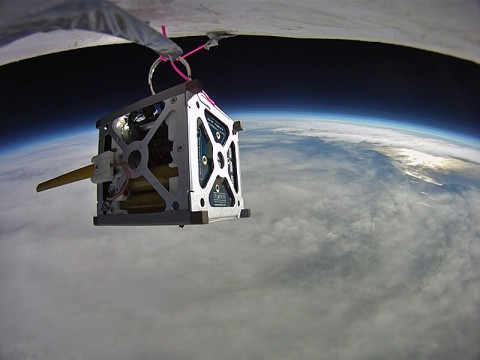NASA
 Washington, D.C. – NASA’s preparing to send its fifth in a series of smartphone-controlled small spacecraft into orbit. PhoneSat 2.5 will ride into space as part of the SpaceX-3 commercial cargo resupply mission to the International Space Station.
Washington, D.C. – NASA’s preparing to send its fifth in a series of smartphone-controlled small spacecraft into orbit. PhoneSat 2.5 will ride into space as part of the SpaceX-3 commercial cargo resupply mission to the International Space Station.
SpaceX-3 is scheduled to lift off from Cape Canaveral Air Force Station in Florida at 4:41am EDT Sunday, March 16th.

The technology demonstration mission also will pave the way for a constellation of cooperative small satellites scheduled to launch later this year.
“If I showed PhoneSat to you, you’d ask, ‘where’s the phone?’,” said Bruce Yost, program manager for NASA’s Small Spacecraft Technology Program at NASA’s Ames Research Center in Moffett Field, CA. “That’s because although we buy a smartphone off the shelf, much like the one in your pocket or purse, we take it apart and repackage it to fit in the cubesat form and work in space. This differs from the first PhoneSat, that packed in the entire smartphone.”
Selected for launch as part of NASA’s Cubesat Launch Initiative, PhoneSat 2.5 is a one-unit (1U) cubesat spacecraft measuring 10 centimeters square (approximately four inches on each side), using commercially available smartphones.
The mission has three objectives: determine if a low-cost commercially available attitude determination and control system can work in space; verify if a smartphone can support space-based communications systems; and provide further confidence in the PhoneSat concept and components by investigating its ability to survive long-term in the radiation environment of space.
“NASA is using these pioneering small spacecraft missions to gauge the use of consumer-grade smartphone technology as the main control electronics of a capable, yet very low-cost, satellite,” said Andrew Petro, program executive for the Small Spacecraft Technology Program in the Space Technology Mission Directorate at NASA Headquarters in Washington, which funds the PhoneSat series.
PhoneSat 2.5 is equipped with a higher-gain S-Band antenna, which serves as a pathfinder for future NASA missions, including the Edison Demonstration of Smallsat Networks (EDSN) mission scheduled to launch later this year.
Each satellite will be able to cross-link communicate with the others so that engineers can study space-to-space communications and how small, low-cost, powerful satellites can perform space weather monitoring duties.
In addition to the large memory, fast processors, GPS receivers, gyroscope and magnetometer sensors and high-resolution cameras commonly found in smartphones, the PhoneSat 2.5 also houses a low-cost commercial attitude determination and control system that contains reaction wheels that by slowing down or speeding up, can rotate the satellite.
Engineers hope to determine if this control system can orient PhoneSat in space, a critical capability for satellites that may need to point towards a specific object of scientific interest like an asteroid, star or features on Earth. The missions also gather further information about the orbital lifespan of the smartphone components.
“By advancing the price performance of nanosatellites using consumer electronics, we can make some of the more radical ideas become economically viable,” said Jasper Wolfe, PhoneSat Control System lead at NASA Ames.
PhoneSat 2.5 builds upon the successful flights of previous NASA smartphone satellites launched last year. PhoneSat 2.4 launched last November and achieved its primary mission objectives, demonstrating a smartphone can serve as an avionics controller. It also demonstrated the use of its magnetometer and an Ames-designed magnetorquer to actively align the satellite’s orientation with Earth’s magnetic fields.
PhoneSat 2.4 continues to transmit data, which means its solar arrays, battery charging circuit, Arduino watchdog and data router are still operating correctly. In early January, however, the Phonesat 2.4 smartphone began to experience recurring resets coinciding with a period of numerous solar flares. As a result, the satellite no longer executes flight application software.
“We expect PhoneSat 2.5’s orbital lifetime to be as long as six weeks” said Cedric Priscal, PhoneSat software lead at Ames. “This operation time will help us demonstrate that the system can survive being exposed to the doses of space radiation all satellites must endure in low Earth orbit, and help us gather data on the effects radiation has on the satellite.”
What kind of smartphone has a battery life of six weeks? NASA equipped the six sides of the PhoneSats with solar panels to help replenish the batteries and keep the spacecraft alive.
PhoneSat 2.5 also includes a higher-gain two-way S-band radio communications capability. Engineers will test the radio’s capability to send commands to the spacecraft and telemetry back to ground station on Earth, in preparation for NASA’s Edison Demonstration of Smallsat Networks (EDSN) mission, scheduled for launch late this year.
While orbiting Earth, ground station controllers at Santa Clara University in California, also will attempt to command PhoneSat 2.5 to transmit photographs of what it sees using the smartphone’s camera to gather information for future low cost onboard camera systems and star trackers.
“The next step is to add a propulsion system to pave the way for cubesats to explore further into the solar system,” said Oriol Tintore, PhoneSat mechanical lead at Ames.
Though it’s unlikely you’ll find one of those on your smartphone anytime soon.
The PhoneSat series of technology demonstration missions is funded by the Small Spacecraft Technology Program, in NASA’s Space Technology Mission Directorate at NASA Headquarters and the Engineering Directorate at Ames.
For more information about NASA’s Small Spacecraft Technology Program and the PhoneSat series of cubesats, visit: http://go.usa.gov/KWRP


